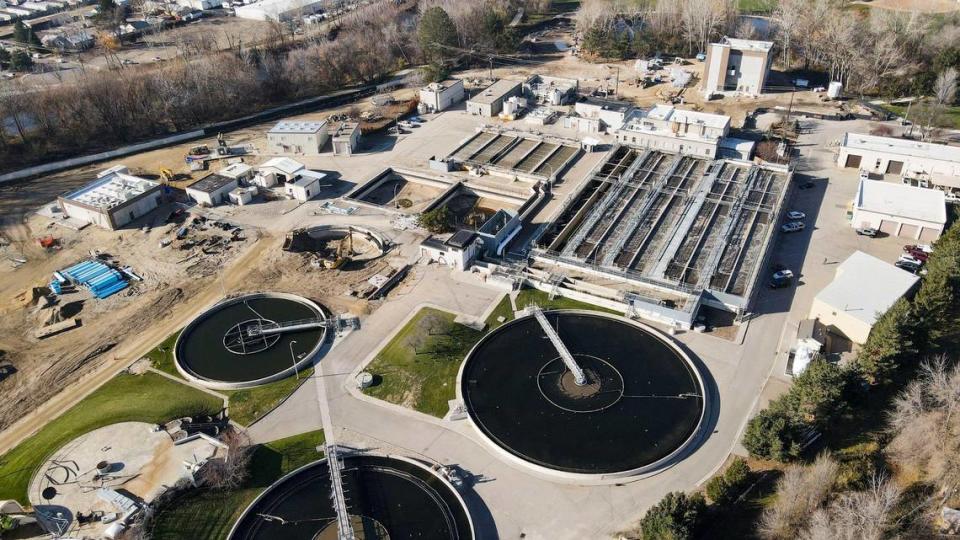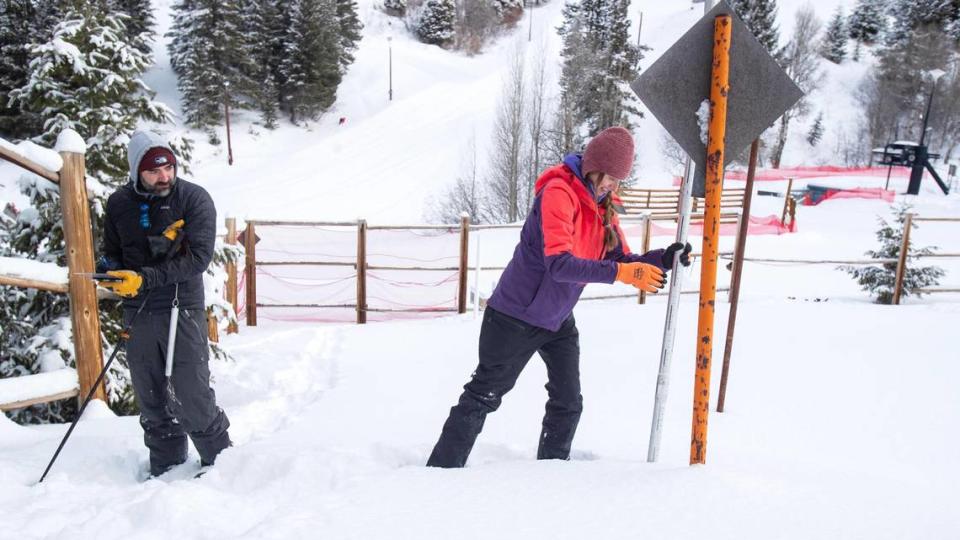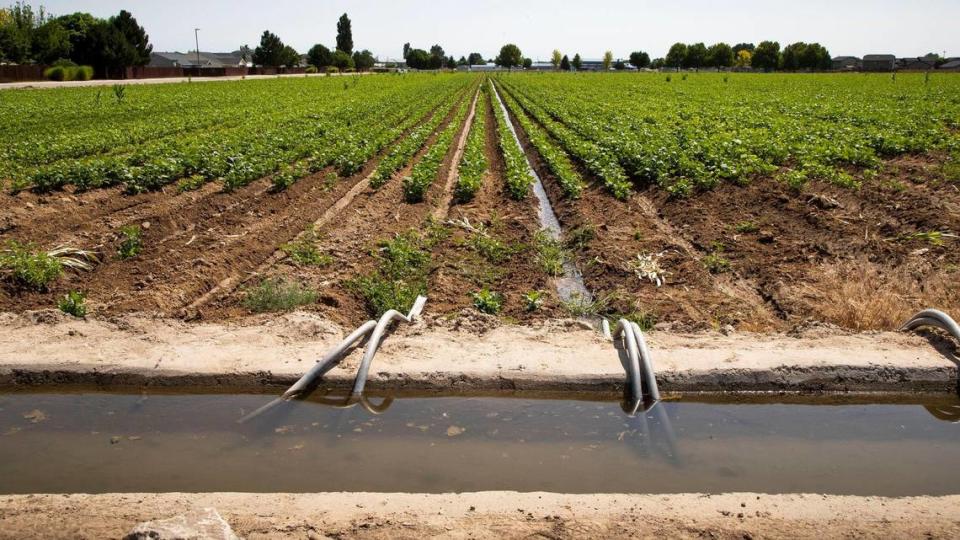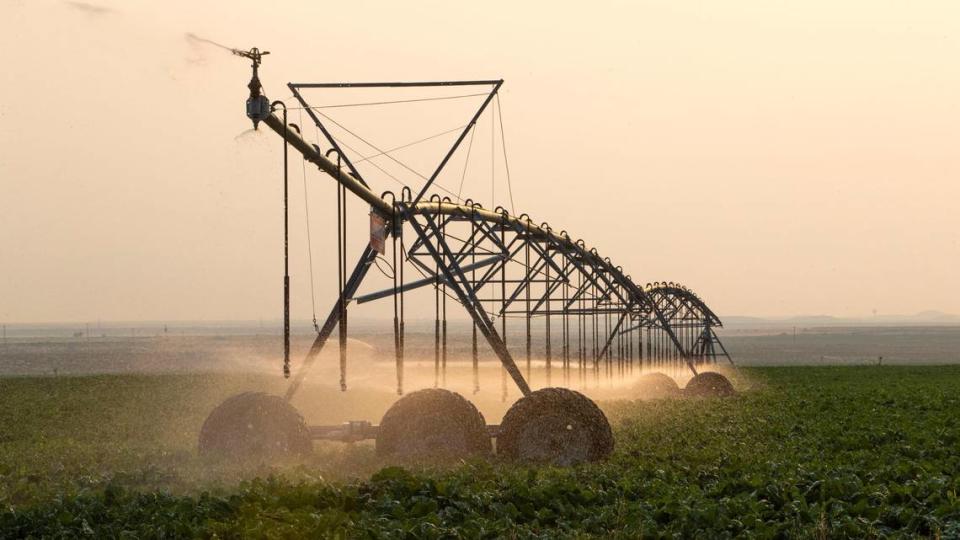Can Boise avoid the water crisis that plagues the West? Maybe. But we’re vulnerable, too
Waning snowpack. Shorter irrigation seasons. Streams trickling where they once cascaded.
In Idaho, water supply trends foretell challenges because of climate change, which drives extreme weather and is expected to disturb the state’s water resources. That could spell trouble for a rapidly growing state.
Stream flows in the state have already declined by a fifth, according to research, and the coming decades could see many winters with little to no snowpack — a key reservoir that releases water in the spring and summer and supplies the state’s farms and homes.
The Gem State has long fostered booming agriculture that soaks up more water than any other sector. And as more land shifts from tilled soil to subdivisions, more of Idaho’s rivers could flow to consumers instead of farms. Water demand in the Treasure Valley is expected to rise by 5% by 2060, according to a study by hydrologist Christian Petrich.
Petrich, who last year created a report on the future of the Boise area’s water supply, told the Idaho Statesman in an interview that now is the time to act if the Treasure Valley wants to ensure its water resources keep up with increased demand. That will require money, planning and cooperation between numerous stakeholders, he said.
“We could switch from good water supply years to poor water supply years very quickly,” Petrich said, “and I think having plans to address that is going to be very important.”

Western states confront climate change
Across the West, states are confronting the reality that growing populations have run up against limited water supplies. On the Colorado River, which originates in its namesake state and reaches to the Gulf of California, decades of overuse coupled with drought have depleted the waterway. In fast-growing St. George, Utah, and the agriculture-heavy Central Valley of California, the strain is on underground aquifers.
Idaho’s high mountain ranges — which are less than 50 miles from Boise — are a natural reservoir system, packing in water as snow during the winter and releasing it as snowmelt in the spring and summer.
But by the end of the century, Idaho could see 35-65% reductions in its snowpack, according to research published in Nature, which predicts drop-offs in annual snowfall in mountain ranges across the West. The study predicted that between 2050 and 2100, most of those years could see little to no snowpack if humans don’t drastically curtail greenhouse gas emissions.
“We have not seen the level of drought that the Colorado River has seen here in the Snake River Basin,” said Lejo Flores, an associate professor in the Department of Geosciences at Boise State University. “But it’s very possible that our days are numbered with that.”

Science outcomes can also be difficult to predict without proper equipment. Flores said Idaho’s climate monitoring system is less robust than that of other states, which could mean Idaho is partially “flying blind.”
But changes have already happened to the water landscape in the state.
Charlie Luce, a hydrologist at the Rocky Mountain Research Station, determined in his research that the flows in Idaho streams have dropped by 20% over the last 60 years.
Changes in rainfall and temperatures could mean shifts in when mountains reach their peak snowpack levels. The earlier peak snowpack levels could mean the Treasure Valley will run low on water in the fall, at the end of the irrigation season.
“There’s going to be a lot of pressure to start tapping into that groundwater bank account more and more” as surface water shrinks, Flores said.
But the hardest factor to predict? How humans respond to climate change, Flores said.
“That’s the biggest source of uncertainty that we in the climate science community have,” he said. “Forecasting people is not something that I was trained to do.”
Water use expected to grow in Boise area
In the last 20 years, the Boise metropolitan area’s population has ballooned nearly 60% from 296,000 people to 470,000. As the demand for water grows, the supply could dwindle because of the effects of climate change.
While precipitation is hard for climate scientists to predict — some models suggest higher overall rainfall, and others suggest less — it could have major implications for water use. Scenarios predicting earlier spring rains combined with melting snowpack could cause flooding, while scenarios with declining water supply could force regulators to dip into stored water as much as a month earlier in the irrigation season than they do now.
Like many regions, the Treasure Valley gets its water through a combination of groundwater from the Snake River Aquifer and surface water, mainly from the Boise River. Veolia, the largest private water supplier in the Boise area, pulls 70% of its water from the aquifer, using wells to penetrate or pump an underground layer of rock that’s saturated with water. The bulk of the rest of the water supply comes from the Boise River system.
According to Veolia numbers, the company’s 260,000 customers use an average of 20 million gallons of water a day in the winter and 90 million in the summer, when there’s outdoor landscaping and lawn watering.
The water supply is managed by myriad entities: Veolia in Boise; municipal water utilities in Garden City, Eagle and Caldwell, and the Idaho Department of Water Resources. Water rights are also managed by irrigation districts and canal companies.
The Boise area will have multiple options to choose from to fulfill its future water needs — but officials need to start planning for them now, according to Petrich’s report, which was commissioned by Veolia.
Petrich said some additional water could be taken from existing sources by pumping more groundwater from the aquifer or diverting more water from the Boise River. But that alone won’t be enough to meet the projected rise in demand, he said.
“I think that the Treasure Valley has better water supply options than many other arid Western cities, but developing that supply will not come easy,” Petrich said.
In Idaho as in other states, agricultural use dwarfs other water uses. Two million acre feet of water flow into the Treasure Valley every year, mostly through the Boise River — and 80% of that is diverted into canals for farms, according to the Idaho Department of Water Resources. Every acre-foot of water is enough to cover an acre of ground in water 1 foot deep.

But as the Valley changes, municipal water use is expected to grow significantly. Though agriculture use is expected to decline, the uptick in municipal, commercial and industrial demand could mean more water use.
Petrich suggested new water sources, such as increasing reservoir storage along the Boise River at Anderson Dam. He said water could potentially be piped in from the Snake River, though that infrastructure would likely prove costly.
One major possibility is recycled water — Petrich noted as much as 95% of municipal water used in the area becomes wastewater, which is treated and returned to waterways, including the Boise River. Instead, that recycled water could be used for irrigation, aquifer recharge and more.
Years ago, the city of Meridian piloted a water reuse project at Heroes Park, where “reclaimed” water is used for irrigation and toilets. More recently, Micron began recycling water at its Boise plant to reduce the water consumption in its manufacturing process, and Boise officials are testing a recycled water pilot system that they plan to expand in the coming years.
“Right now it goes in the river and goes downstream,” Haley Falconer, the environmental manager at the city’s Department of Public Works, said at a Boise City Council meeting in August. “But we have an opportunity here to create a drought-proof water supply.”
Those solutions won’t come without challenges. Because of the patchwork of suppliers and sources in the Boise area, Petrich said it will be crucial for everyone to begin working together to develop a plan.
In Petrich’s report for Veolia, he predicted that municipal usage would at least double by 2065 as the area grows. He told the Statesman that Boise’s growth has already exceeded estimates he laid out in a 2010 report for the Idaho Department of Water Resources.
“Water supply development for the Treasure Valley has been relatively easy in the past,” Petrich told the Statesman. “Managing water supply will become more challenging, especially in the context of a changing climate where we can go from relatively good water years to very dry years in a very short amount of time.”
Climate change is one of several factors that lend a level of uncertainty to the future of the local water supply. A lot could impact water: How much will Boise’s population grow? How much water will we use? Even the amount of groundwater — and how much of that is accessible or even fit to use because of its quality — is unclear.
“The trick with groundwater is it’s like having a bank account, but you don’t know how much water is in it,” Flores said.
Should we reallocate resources from agriculture?
As the Treasure Valley grows and the region’s land use shifts away from agriculture and toward development, some argue that water uses aren’t shifting in tandem with the changes in land ownership as they should.
Water rights are legal entitlements to use water for a beneficial purpose. Like other kinds of property, they can be bought and sold. Generally, water rights are controlled by canal companies and irrigation districts.
The big players in Idaho’s network of water rights are irrigators, the farmers around the state who use most of the water. But while agricultural land in the Treasure Valley is rapidly urbanizing, the water formerly used by farmers often isn’t going to a new use, according to Jeff Fereday, a retired water attorney at Givens Pursley.
“If a 100-acre farm is turned into a highway interchange and a big box store, there’s essentially zero irrigation demand on that parcel now,” Fereday said. While stores and residences need water for drinking, bathrooms and appliances, they don’t generally use much irrigation water, which is usually untreated and diverted from rivers. And the level of water they do use is usually much less than an irrigated field, Fereday said.
But the new owners of the land generally retain the original access to the irrigation water, even if the property is no longer using much of it.

Ada County saw irrigated farmland drop by nearly half from 1978 to 2007, according to data from a paper Fereday published on the topic.
When such properties change hands, they raise a question: What happens to that irrigation water that was being used to grow crops? Is it all still being used? Or if not, is it being diverted to no use?
“More often than not, what we see here in the Valley is that it’s being diverted to no use,” he said.
That’s unusual, Fereday said. In other states, like Colorado, unneeded water rights are routinely transferred when the irrigation need goes away. And if water is no longer being put to “beneficial use,” an entity forfeits its water right, he said.
Like other properties, water rights can be bought, sold or leased. Water rights are variously controlled by private owners, canal companies and irrigation districts. Sometimes rights are sold along with a parcel of land, and other times they are sold separately, Mike Lawrence, a partner at Givens Pursley, told the Statesman. Until now, the Treasure Valley hasn’t “felt the pinch” on its water supply, which has kept a more robust market from developing, he said.
“When it comes to these large canal companies and irrigation districts, they just simply have a tradition of not ever selling any of their water rights,” Fereday said. “There are exceptions, but they’re minor exceptions.”
If a former farm is turned into a subdivision, much of the water diverted for irrigation is likely no longer in use but is still reserved for the same area, Lawrence said. While a square foot of lawn may use more water than some low-intensity crops and unregulated subdivisions may water at higher volumes than farms do, the sheer amount of land now covered should equate to major water savings, both Fereday and Lawrence said. That means much of that water simply flows out of the canal and back into the river. Lawrence said he doesn’t know of any entities that measure how much diverted water is actually used, or how much is discharged.
“If (we’re) pulling water out of the river and sending it down the canal and it never gets applied to irrigation use and then it just winds up back in the Boise River miles downstream and off to Oregon and Washington, has that been beneficially used?” Lawrence said. “I think everybody should have the common goal of keeping Idaho water in Idaho.”
If the Treasure Valley’s water needs get more constrained in the future, that extra water may get more attention.
“I think that cities could be doing substantially more in the planning process that would help quantify land that is becoming paved over and help some of the irrigation entities rethink opportunities for how that water could be used otherwise,” Petrich told the Statesman.
Fereday thinks the urbanizing shifts have a major impact on the entire picture because “our development is galloping out over irrigated ag land.”
That means repurposing irrigation water could be a big part of the solution, he said.
“But if we’re going to say that irrigated farm water is forever off limits from a transfer or going into people’s homes or into factories or whatever, well then we’re screwed,” Fereday said. “Then we just denied ourselves the biggest piece of resource that we have.”
The water outlook is “extremely good if we’re talking about transferring ag water,” he said. “If that is off the table, it’s extremely bad. It’s that simple.”

